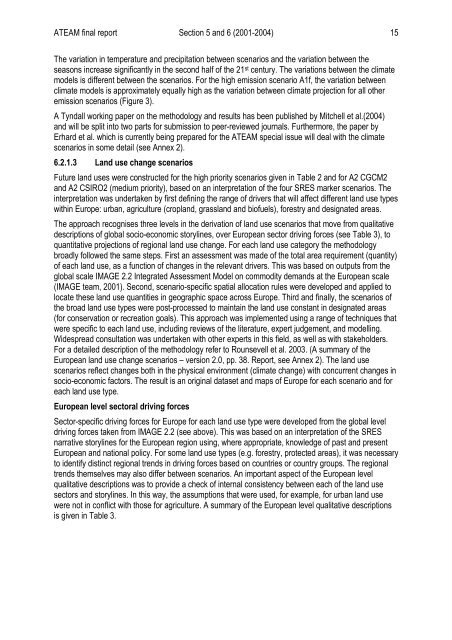ateam - Potsdam Institute for Climate Impact Research
ateam - Potsdam Institute for Climate Impact Research
ateam - Potsdam Institute for Climate Impact Research
Create successful ePaper yourself
Turn your PDF publications into a flip-book with our unique Google optimized e-Paper software.
ATEAM final report Section 5 and 6 (2001-2004) 15<br />
The variation in temperature and precipitation between scenarios and the variation between the<br />
seasons increase significantly in the second half of the 21 st century. The variations between the climate<br />
models is different between the scenarios. For the high emission scenario A1f, the variation between<br />
climate models is approximately equally high as the variation between climate projection <strong>for</strong> all other<br />
emission scenarios (Figure 3).<br />
A Tyndall working paper on the methodology and results has been published by Mitchell et al.(2004)<br />
and will be split into two parts <strong>for</strong> submission to peer-reviewed journals. Furthermore, the paper by<br />
Erhard et al. which is currently being prepared <strong>for</strong> the ATEAM special issue will deal with the climate<br />
scenarios in some detail (see Annex 2).<br />
6.2.1.3 Land use change scenarios<br />
Future land uses were constructed <strong>for</strong> the high priority scenarios given in Table 2 and <strong>for</strong> A2 CGCM2<br />
and A2 CSIRO2 (medium priority), based on an interpretation of the four SRES marker scenarios. The<br />
interpretation was undertaken by first defining the range of drivers that will affect different land use types<br />
within Europe: urban, agriculture (cropland, grassland and biofuels), <strong>for</strong>estry and designated areas.<br />
The approach recognises three levels in the derivation of land use scenarios that move from qualitative<br />
descriptions of global socio-economic storylines, over European sector driving <strong>for</strong>ces (see Table 3), to<br />
quantitative projections of regional land use change. For each land use category the methodology<br />
broadly followed the same steps. First an assessment was made of the total area requirement (quantity)<br />
of each land use, as a function of changes in the relevant drivers. This was based on outputs from the<br />
global scale IMAGE 2.2 Integrated Assessment Model on commodity demands at the European scale<br />
(IMAGE team, 2001). Second, scenario-specific spatial allocation rules were developed and applied to<br />
locate these land use quantities in geographic space across Europe. Third and finally, the scenarios of<br />
the broad land use types were post-processed to maintain the land use constant in designated areas<br />
(<strong>for</strong> conservation or recreation goals). This approach was implemented using a range of techniques that<br />
were specific to each land use, including reviews of the literature, expert judgement, and modelling.<br />
Widespread consultation was undertaken with other experts in this field, as well as with stakeholders.<br />
For a detailed description of the methodology refer to Rounsevell et al. 2003. (A summary of the<br />
European land use change scenarios – version 2.0, pp. 38. Report, see Annex 2). The land use<br />
scenarios reflect changes both in the physical environment (climate change) with concurrent changes in<br />
socio-economic factors. The result is an original dataset and maps of Europe <strong>for</strong> each scenario and <strong>for</strong><br />
each land use type.<br />
European level sectoral driving <strong>for</strong>ces<br />
Sector-specific driving <strong>for</strong>ces <strong>for</strong> Europe <strong>for</strong> each land use type were developed from the global level<br />
driving <strong>for</strong>ces taken from IMAGE 2.2 (see above). This was based on an interpretation of the SRES<br />
narrative storylines <strong>for</strong> the European region using, where appropriate, knowledge of past and present<br />
European and national policy. For some land use types (e.g. <strong>for</strong>estry, protected areas), it was necessary<br />
to identify distinct regional trends in driving <strong>for</strong>ces based on countries or country groups. The regional<br />
trends themselves may also differ between scenarios. An important aspect of the European level<br />
qualitative descriptions was to provide a check of internal consistency between each of the land use<br />
sectors and storylines. In this way, the assumptions that were used, <strong>for</strong> example, <strong>for</strong> urban land use<br />
were not in conflict with those <strong>for</strong> agriculture. A summary of the European level qualitative descriptions<br />
is given in Table 3.
















